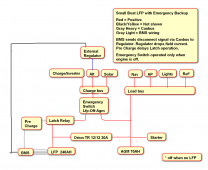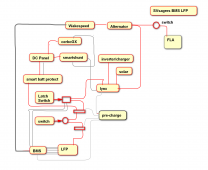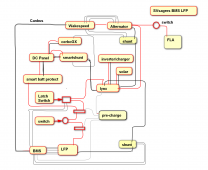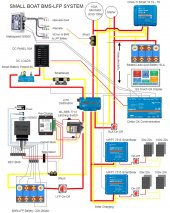There are many designs based upon preference and existing equipment and space. This is a schematic attempt for a simple and safe system with a SLA battery backup in a small boat (Bristol32) with limited space for much gear. This is definitely not entirely worked out, so comments and suggestions will be appreciated. The goals are as follows:
Cruisers Forum - Lithium Power System Thread
Attainable Cruising - Building a Seamanlike LFP Battery System - John Harries - Hybrid
Nordkyn Design - Lithium Battery Systems - Dual bus - Some design schematics
Some Pictures from my boat upgrade - SVsagres - Hybrid
The note "Pre Charge delays latch operation" is incorrect and should be removed. Wakespeed WS500 and REC BMS are planned. The latch relay may be similar to the Bluesea 7713 that SVsagres used. This schematic has the DC panel connected to a 70A SLA battery which is being charged by the LFP and Alternator through the Orion TR DC-CD 12/12 30A adjustable charger. The Orion is backup spike protection for the alternator in case of an unexpected BMS shutdown. We may use a small adjustable LFP 15A charger (with bluetooth) if available, instead of a bigger Victron Multiplus inverter/charger. We have no 120vac loads and are on a mooring, although if we are connected to shore power, we could plugin the refrigerator, domestic hot water and a few gfi plugs. I still have to figure out where this DC equipment and the batteries can fit inside the cabin.
One of my questions is where the Regulator sense leads should be placed, and how the Wakespeed WS500 will be wired so that it is regulated when only the AGM battery is online. What changes would need to be made?
There very possibly is several levels of backup in the event of failure:

- Safe
- Simple
- Expect an LFP shutdown sometime, at the worst time.
- Seamless use of SLA Battery Backup with no interuption.
- SLA Capacity large enough to provide 5 hrs using just critical loads.
Cruisers Forum - Lithium Power System Thread
Attainable Cruising - Building a Seamanlike LFP Battery System - John Harries - Hybrid
Nordkyn Design - Lithium Battery Systems - Dual bus - Some design schematics
Some Pictures from my boat upgrade - SVsagres - Hybrid
The note "Pre Charge delays latch operation" is incorrect and should be removed. Wakespeed WS500 and REC BMS are planned. The latch relay may be similar to the Bluesea 7713 that SVsagres used. This schematic has the DC panel connected to a 70A SLA battery which is being charged by the LFP and Alternator through the Orion TR DC-CD 12/12 30A adjustable charger. The Orion is backup spike protection for the alternator in case of an unexpected BMS shutdown. We may use a small adjustable LFP 15A charger (with bluetooth) if available, instead of a bigger Victron Multiplus inverter/charger. We have no 120vac loads and are on a mooring, although if we are connected to shore power, we could plugin the refrigerator, domestic hot water and a few gfi plugs. I still have to figure out where this DC equipment and the batteries can fit inside the cabin.
One of my questions is where the Regulator sense leads should be placed, and how the Wakespeed WS500 will be wired so that it is regulated when only the AGM battery is online. What changes would need to be made?
There very possibly is several levels of backup in the event of failure:
So perhaps the AGM would just be charged at 13.2v which really isn't adequate. Your suggestions, comments and experience are welcome.SVsagres wrote: If I get a BMS failure, I can force the system on and limp home (the Wakespeed will go to 13.2v if it doesn't hear from the BMS), but additionally my engine start battery is a basic marine start FLA. The engine itself is basically clockwork (Yanmar 1GM10) so I can go a long time without recharging the start battery. ...If things go bad, I can always manually force the 7713 on with the knob. ..
The BMS is in full control of the charging system, if the rest of the charging system loses contact with the BMS, it goes into a safe mode.
If the WS500 stops receiving CAN messages, it will drop into “limp” mode, setting its voltage limit to 13.2v, which is pretty safe.

Last edited:





